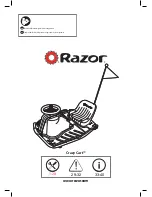
19
SPECIAL CIRCUMSTANCES
1. Any time you suffer a crash or extremely heavy landing you should have an “annual” inspection done
on your wing to insure that you find all damaged parts.
Heavy landings may also impose very high loads on the sprogs and bridle lines. Inspect them
accordingly.
2. If your wing is ever exposed to salt water you will need to have the wing completely disassembled in
accordance with the recommended annual inspection procedure. All frame parts will need to be
disassembled, including the removal of all sleeves and bushings, flushed liberally with fresh water and
dried completely.
3. If you fly in a dusty or sandy environment, it will help to prolong the life of your batten pockets if you
wipe each batten with a rag before you install it in the sail.
4. A wet wing must be dried before storing. Do not leave your wing wet for more than one day, because
corrosion may result.
5. Take special care to avoid ice-covering the wing, particularly the leading edge in wintertime.
6. If you fly regularly at the coast in windy conditions, be aware that the sea mist spray can have the
same effect. Hose down your wing after such flights, and keep a special lookout for corrosion.
7. Keeping your sail clean will extend the life of the cloth. When cleaning the entire sail you should
generally use only water and a soft brush. You may clean small spots or stains with any commercial spot
remover that is labeled for use on polyester.
A NOTE ABOUT CABLES AND CABLE MAINTENANCE
The cables which support the wing’s airframe are critical components of the wing’s structure, and must be
maintained in an airworthy condition. It is a general practice in the design of aircraft structures to design
to an ultimate strength of 1.5 times the highest expected load in normal service.
The wing’s cables, like other structural components on the wing, are typically designed with a structural
safety factor of only about 50% above the expected maximum load. No significant loss in cable strength
can be tolerated.
A cable with even a single broken strand must be replaced before the wing is flown again. A cable which
has been bent sharply enough to have taken a permanent set must also be replaced immediately.
Some degree of fatigue due to repeated bending of cables is almost unavoidable in an aircraft that is
assembled and disassembled regularly.
SPROG MEASUREMENT
The Fox 13TL uses inboard and outboard sprogs in combination with one transverse batten on each
inboard sprog. Each transverse batten spans two top surface battens, so a total of six top surface battens
are supported. The sprog system is the primary component of the system, which provides pitch stability.
The function of the system is to support the trailing edge of the sail at low angles of attack, and thus
provide a nose-up pitching moment. The inner sprogs are adjusted at the factory to their proper settings.
The outer sprogs are non-adjustable.
The inner sprog angles should be checked regularly. This can be done with any digital electronic angle
meter as follows:
1. Fully set up the wing o a reasonably level surface.
2. Rest the keel tube on a support and using the angle meter as shown on the figure 42, set the angle
meter to zero. Maintain this keel tube angle during further measurements.














































